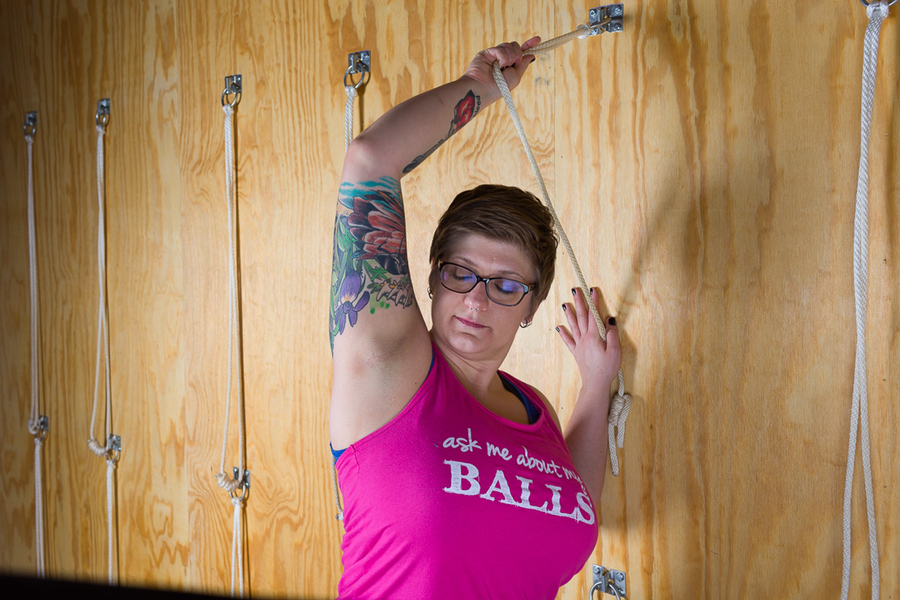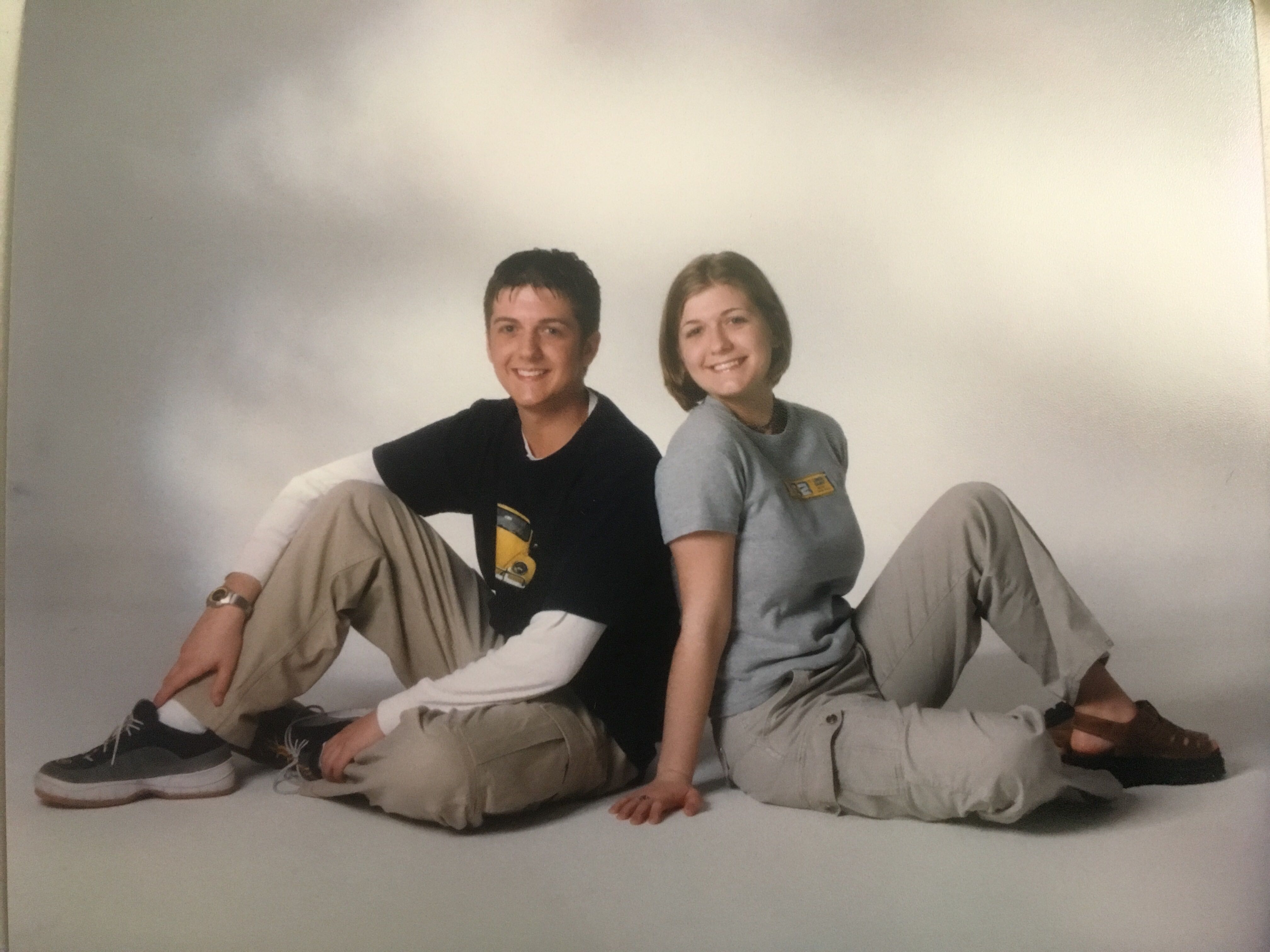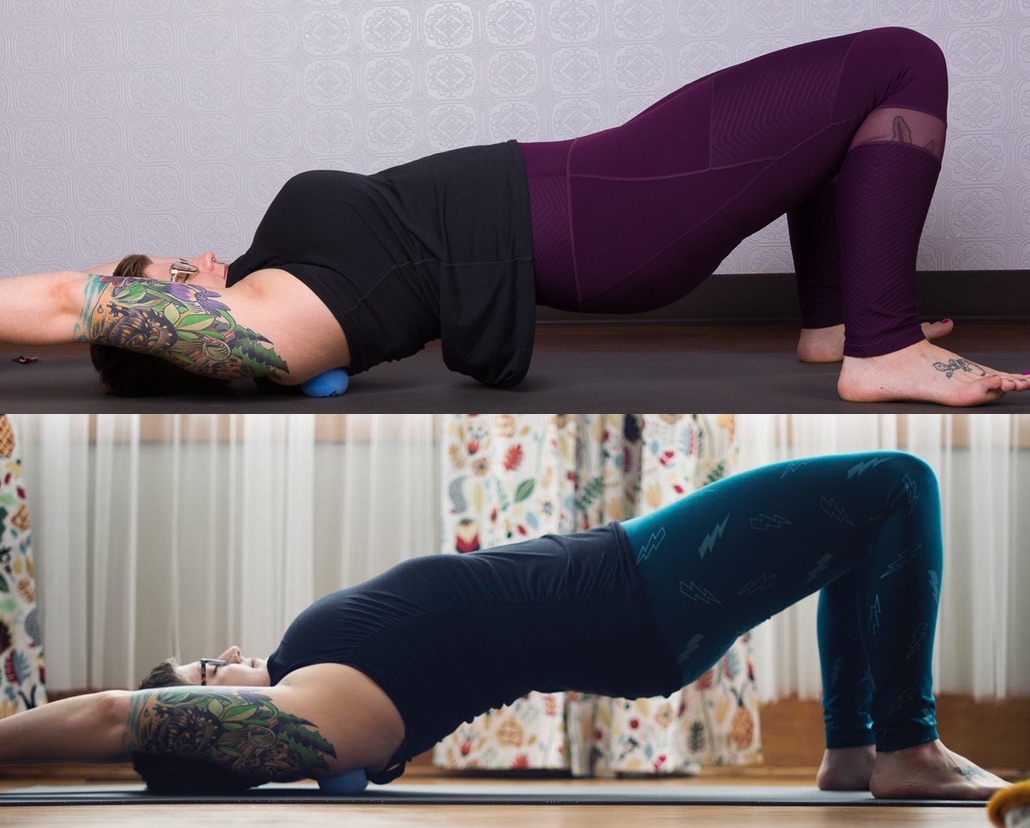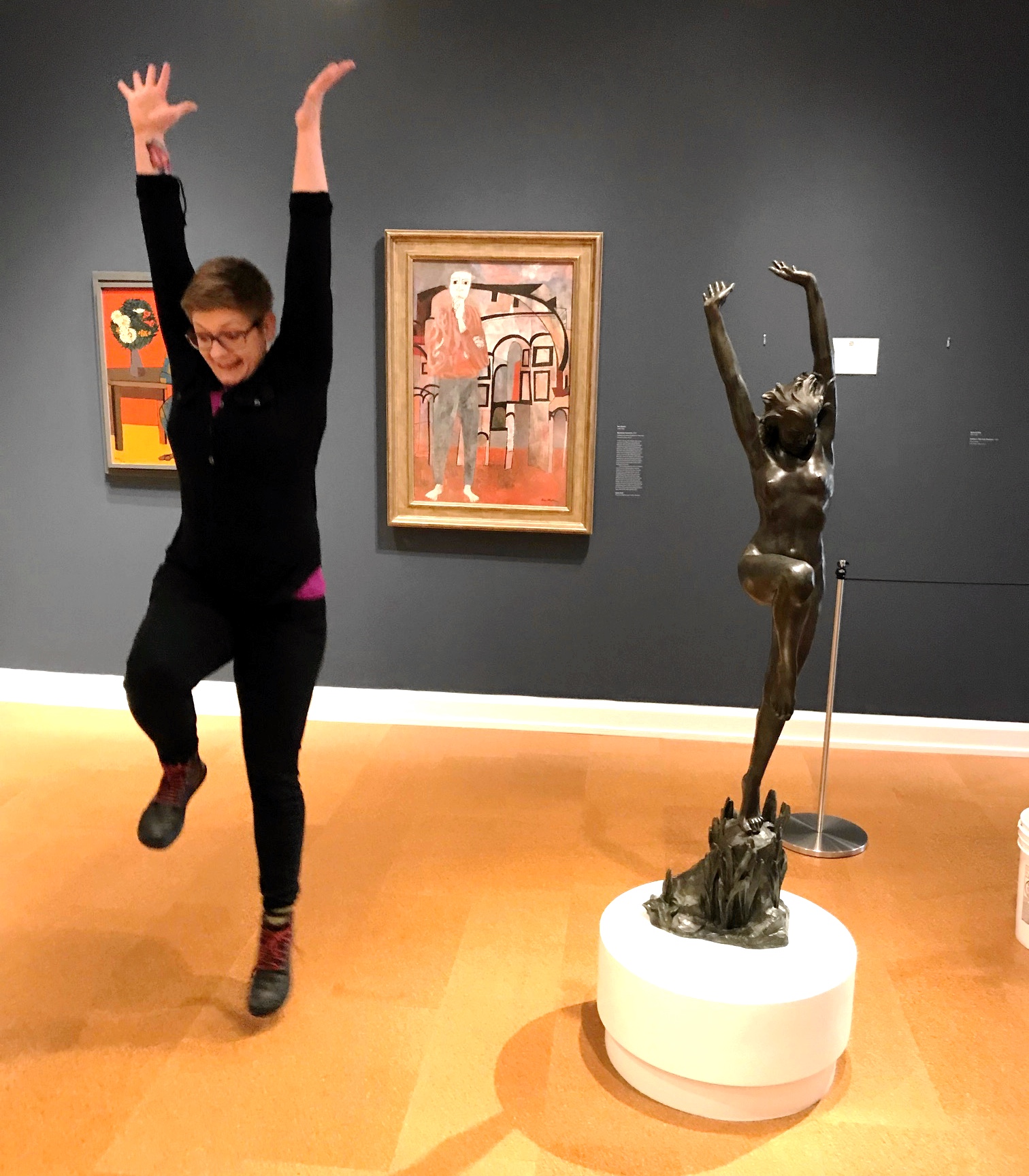
“If you’re going to continue doing CrossFit, you’ll need to have a breast reduction,” my very direct gynecologist told me one year as she performed my breast exam. It wasn’t that I hadn’t thought about it before, but the struggle was amplified by my newly active lifestyle.
Surgery, though? Too scary. Too expensive. Too much time away from work. Anxiety would play no small part in avoiding pursuing breast reduction surgery for a number of years.
Early Unwanted Attention

I remember being around 13 the first time I received unwanted attention for my shape. I was wearing a red bathing suit that my mom had ordered from the women’s section of a Land’s End catalog. Playing around a pool at a summer gathering with a bunch of my dad’s colleagues, grown men made comments about my body. I was a child.
It didn’t take long for me to consciously begin covering up. By the time I was in junior high, I was in a C cup bra. Baggy pants, men’s extra large tee shirts, and a collection of Chuck Taylors. It was a look. I navigated my awkward way into adulthood and eventually convinced myself that the way other people felt about my body was not my concern.
While I could navigate unwanted attention more logically, that young girl inside of me made sure my posture and clothing never revealed too much.
Discovering Yoga in an Atypical Body
I started practicing yoga in grad school with DVDs, and eventually made it to gym and studio practice as those options were affordable. I managed to avoid bouncing around very much until I turned 30.
Enter CrossFit. If finding a C cup bra for a tween was a nightmare, finding a JJ cup bra to hold me in for box jumps and burpees was a quest straight out of Dante’s Inferno. And don’t even get me started on bathing suits. This was when I shrugged off my gynecologist’s mention of breast reduction surgery.
But I was determined to move this body: To lift heavy things and put them back down, to practice every form of yoga I had time to try. For the first time in my life, I wore tank tops to work out. My family began to question my sanity as yoga leggings crept into my wardrobe.
The more I moved, the more I wanted to learn. The more I moved, the more I found I couldn’t move the way many people could. My shoulder flexion was crap. My ribs jutted out from beneath my heavy breasts as I struggled to move weight overhead. My neck and shoulders hurt, but that wasn’t new.
Finding Body Acceptance While Becoming a Teacher
In 2015, I decided to take my 200 hour yoga teacher training. To claim that I did not have to take time to process my body being the center of attention would be a lie.
I was able to study one-on-one with my teacher, Joni McCarran, who encouraged me to be honest with my students and develop my own voice in the classroom. Often this involved finding modifications that she was not familiar with. She gave me the freedom, encouragement, and resources to explore what teaching in my body would entail.
While I was concerned with stepping into a class and seeing confused looks of students expecting the teacher to be a certain shape (slender and lithe) and teach advanced postures, I began to develop my own realm of expertise. In 2016, I had Joni’s full support as I immersed myself in the Yoga Tune Up® teacher training, and a year later became a Roll Model® Method Practitioner.
As I boosted my anatomical literacy and self-care practice, my own aches and pains became harder to ignore. In my YTU final essay, I declared “I’ve got a real love-hate relationship with the trapezius. On the one hand, as a migraine sufferer, desk sitter, and carrier of mighty heavy bosoms, I am constantly turning my neck at some weird angle to stretch, adjust, or otherwise move the upper edge of my traps. Massage, yoga, therapy ball rolling, targeted mobilizations…the relief is generally brief at best.”
This exploration of my body allowed me to more accurately advocate for my own healthcare.
Making the Choice to Get Breast Reduction Surgery
In my 37th year, I made my final move. After six months of regular chiropractic care, which included a therapy routine and massage, I consulted with a surgeon. I submitted my paperwork to see if the years of shoulder indents, headaches, jaw clenching, skin fold rashes, terrible posture, and a constantly restrained rib cage (do you know what a JJ cup bra looks like?) qualified a breast reduction as “medically necessary” according to my insurance company.
The letter came a few weeks later; my life was about to change.
“Large Breasts” read the diagnosis on my chart. “No shit,” I thought. And away I went to prepare my body and my brain for what was about to happen to it.

Mindset and Practices to Prepare for Breast Reduction Surgery
As if her training and methods hadn’t helped me enough, Jill Miller took the time to hold space for me as I prepared for surgery: “Pray with your breath as you are wheeled into surgery, no matter what you are feeling, pray with your breath and remind your breasts that you love them, and that they’ve been a wonderful part of your life. You respect them and even when they’re gone, you appreciate all the lessons and life they’ve given you.”
In the weeks before surgery, guided by Jill’s advice, my practice was focused on manipulating my rib cage through breath, movement and self-massage. My Coregeous® ball traced the outline of my torso, pulling and kneading my tissue. I was ready.
When they wheeled me away from my family to begin surgery, I inhaled, I exhaled. Praying may not be the right word for me personally, but it felt right to acknowledge and thank my body as Jill had so beautifully suggested.

What Happens During and After Breast Reduction Surgery
Bilateral breast reduction mammaplasty by the inferior pedicle technique leaves large incisions horizontally under the breast crease and into the armpit area, vertical incisions from the areola that continue under the breast to meet up with the horizontal incision, and incisions all the way around the areola (which have been trimmed to match the smaller breast). Holy wound-healing, Batman!
I am not a squeamish person, but the first time my mom and I removed my bandages, I nearly passed out.
I knew what to expect. I had watched videos of the entire procedure and had probably looked at hundreds of post-surgery photos at that point, but something about revealing your own body after it has been taken apart and put back together is shocking.
The surgeon had removed 721 grams of my right breast, 690 of my left, and sewn me back up. My mom, a retired nurse (and probably a saint), was equal parts amazed and concerned with my significantly smaller “frankenboobs.”
Between the nausea, swelling, bruising, seeping wounds, pain, and exhaustion, it wasn’t hard not to move for the first week or so after surgery. But I had prepared myself well nutritionally and with years of movement, so after week two, I wanted to do something other than lie around.
Self-care Practice to Heal From Breast Surgery

Jill had told me in our email before surgery, “your RIBS are the big deal here. Do not let your intercostals or obliques go fallow, keep them moving!” Aside from breathwork, my first forays into movement after surgery included gentle twists, neck CARs, laying on my Coregeous® ball, and rolling my feet with my Original Yoga Tune Up® Therapy Balls.
I pondered on my Instagram account “Do you know how stretchy the skin of your mid/low rib cage needs to be in order to breathe and twist and reach and move your arms over your head?”
My flesh was healing, but tight and inflamed, and because I was interested in healing well, I was patient with it.
At four weeks, I was cleared to begin practicing yoga and lifting things over five pounds again. At six weeks, I was cleared for exercise.
Since I had the tools to listen to my own body and recognize my limits, I was able to modify my workouts and practice at the studio. My Coregeous® ball was my best friend as I resumed rolling my ribcage all over her.
The first time I was able to place her between my shoulder blades and fully extend my spine in a backbend over the ball, I breathed deeply, expanding my rib cage with my intercostals, my abdomen elastic, my torso unencumbered by a tightly-bound cage of underwire, I was elated. I could hardly believe the body I was breathing in.
Recently, I received my own “before” photos in the mail because I had requested them from the surgeon’s office. While I had tracked my healing progress through photos, I had none of what I used to look like. I didn’t hate my body, after all, it had served me well, but why would I photograph something that caused me so much physical and emotional pain?
I slid the photos out of the envelope marked CONFIDENTIAL. I was shocked. How had I managed to do so much in that body?
4 Months Later and I’m “Ready to Dance Around”

Before surgery, I saw a lovely bronze statue of a nude woman leaping for joy with her arms over her head. She seemed to be looking down and celebrating her own beautiful form. I mused on Instagram “I’ve learned every lift, asana, exercise, and technique I know inside this capable but restricted body.” I wondered if I might celebrate my new form.
“I’m just a magic skeleton driving a meat wagon with too much weight on the front, and I’m ready to dance around,” I posted.
By the time this post is live, I will be four months recovered from my breast reduction surgery. My incisions have healed nicely, and I continue to massage them regularly. I have returned to CrossFit, and am learning about all the new things my body can do without that extra meat on the front.
I can now identify with my students who have recovered and healed from surgery, and I bring to my classes my own story of how my self-care practice enabled me to pursue something that had previously terrified me.
The bronze statue I saw at the Westmoreland Museum of American Art was called Joy of the Waters, by Harriet Whitney Frishmuth. I visited her recently, and because I have no fear of acting a fool in public, we got to celebrate together.
Related Article: Fun and Effective Moves to Improve Lateral Strength and Mobility
Learn more about our Therapy Ball Products and Programs
Interested in video and blog content targeted to your interests?












I have a client I hope to share this info with. The corgeous ball is a best friend ! Stay strong and healthy Ty
This blog warmed my heart! The different journeys that women go through…it brought up so much. It is disgraceful how society treats young girls when their bodies ‘stand out’ and how much trauma it creates while you are trying to hide your body, the amount of shame that you carry with the years. I love how the world is shifting in women’s consciousness and I hope these topics are addressed. I also believe the topic of breast reduction is dependent on lifestyle – clearly Tiffany was in a journey where she felt the limitation of her body. I hope we can continue living in a world were women’s health is advocated for <3
Hi Tiffany. Your story about your early body image through your recovery from your breast reduction is terrifying….I’m planning on having a breast reduction also. I also have had early body growth for my age and as a result during my life have always worn loose clothes or many layers. Anything bringing me comfort in my own body. I attempted the athletic route in high school playing field hockey and snow skiing, the only sports the only things that interested me but it was all short lived. I was just not an athletic person. Consequently as an older adult now at 64yo I am heavier than I should be I went to Boston to consult with a plastic surgeon and she had three things to say to me. 1) I don’t operate on smokers and you smoke. You need to quit for 3 months. 2) you need to lose the cough and 3) you will need someone to look in on you. That was 61/2 months ago. On the way out of the hospital I threw out all smoking materials in my possession and had no others and never looked back. I haven’t felt this good in 40 years. Consequently I lost the cough and have, due to a totally stupid thing have people in my house every day so that is covered. The only reason ii did not go back at 3 months is because at 4 months had to have a rather involved back surgery with long recovery that I’m still working on.
I plan on going back, but your story I will tell you out pause in my step. I knew it was painful and the recovery long, but the graphics I read were not what I was prepared for. Perhaps when I have more involved sessions with my surgeon I will be more prepared.
Thank you for your story. Your honesty and strength. Your strength showed all through your life. You inspire me. So thanks and never slow down!
Most respectfully,
Sheri Valentine
I am 4 months out from this surgery with extended scars. 6lbs removed. I have no chest or shoulder mobility and my neck pain remains. In fact, it’s worse. I think my scar tissue is pulling down on my chest and causing this pain. Please, do you have any advice? I’m so bummed. I waited so long and worked so hard. But in the end, I have less mobility and even more pain!
Thank you for sharing your story…I also had surgery and found the YTU balls as part of my path to recovery. Until you have surgery you don’t really understand how much your (whatever you had surgery on) is connected to the rest of your body. I learned about fascia and such years and years ago, but to now be able to dive in and really apply it to the healing process was really important as well. Although it’s been almost two years now, I still roll out my gut every Monday morning to start my week off “right” and to remind myself to be gentle and remember that even though it seems long ago, I am still healing 🙂
LOVE this post! Ive been doing crossfit for a few months and my reduction is scheduled for June. I’m stoked to know going back to class is only a few months away!
Hi Tiffany! I just ran across your blog in my prep for my own reduction surgery and I’m in Indy! Thanks for sharing your story. My surgery is in 3 weeks so I’m really honing in on prep and have thought a lot about the size I want to go down to. How small did you go and are you happy with that decision?
Sharing intimate stories like these really do help others. Thank you, Tiffany!
Tiffany, your writing is so entertaining and helpful. Thanks for sharing your story and what worked for you.
Thank you for sharing your story Tiffany. One of my students recently had the reduction procedure. Reading your story has helped me with understanding a bit about her journey too.
Thank you so much for sharing your story with us. I have clients who have undergone this surgery and I feel much more confident being able to help them now. I will also share this post with them so they can hear it first hand from you. I will also share your story with anyone considering surgery so that they can have another perspective and a voice of hope, healing and celebration. I love the image of you dancing for joy next to the sculpture. So much joy!!!
I just wanted to share that way back in 1996 I underwent bilateral breast reduction surgery. I was 45 years old. I’d endured years of relentless back, neck & shoulder pain and at times resorted to wearing 2 bras and even wrapped an ACE bandage around my chest to feel “comfortable” doing any aerobic activity. For those who physically suffer as a result of carrying around large breasts the surgery will provide relief. My suggestion is if you’re considering it, take your time and research then consult with as many plastic surgery specialists as necessary to make an informed choice, discuss the procedure with others who’ve experienced it and request medical insurance coverage. Yes it’s definitely a big decision but one I have never regretted making. It was not only a relief of my symptoms, it was LIBERATING!!
I love your story and thank you for sharing….I truly admire you. Keep doing self care practice. My friend is also thinking of taking surgery for breast reduction. I will tell her your story. Thank you.
As one who’s also lived with unwanted attention, postural/breathing/mobility limitations, encumbered yoga & workouts, constricted circulation c/o underwires and high compression bras/restraints, and the time & money wardrobe expenses suiting up for daily life, I say B R A V A, Tiffany – and Jill – for this post.
I am newly approved for surgery just yesterday – after all the first steps you mentioned: asking my GP to Rx a surgeon’s consult the assesment experience.
I woke up paralyzed with fearful “what if” foreboding.
Voila: your helpful post. Ahhh 🙂
Coregeous Ball, ordered! Tiffgany & Jill, write the book,produce the DVD, please.
I am sitting here recovering from Breast reduction, hoping and wondering about when I will get back to Crossfit, this gives me so much help and reassurance and I am so thankful that you shared your story. I went from a 36G to a 36DD (currently, maybe a D once the swelling is gone) and I am struggling and learning to allow my body to heal.
Triple Wows and all-around thanks for this week’s post. Tiffany! I woke this morning knowing I’d been “cleared” and approved for breast reduction surgery yesterday – after making the decision to go for the initial consult c/o my GP – now had a horrible sense of fearful forboding. I made a note to check in with 2 friends who’d been there, done that. What a serendipitous experience, finding this post and 2 new friends in Jill & Tiffany who gifted such real & relevant information. Priceless! Sending sincere gratitude….
Hello Tiffany,
Exercise is the perfect health topics for keeping your body fitness. I will try it home for my injured body kept well. As a spinal cord injury patient, I am taking physiotherapy regularly for recover my injury very soon. now I am use Mobility Scooter
You’re a hero of mine, Tiffany, and I hope we get to celebrate together soon! Can’t wait to read more from you.
Wow! You are an impressive, beautifully honest woman, a true beauty inside and out. It shocked me, as well, when I was a young girl and grown men made sexual comments. Perhaps our stories will help alleviate that predatory behavior and educate others to stop and think before they make a flippant remark about appearance.
Thanks for your inspiration and honesty. I love how rolling is the turning point — the balls tell us so much about the pain we carry but don’t recognize or can’t acknowledge. Add self-diagnostic tool to the long list of things rolling can do.
Thank you for sharing your story. ?? My daughter had a breast reduction and is so happy she made the decision. She is also very active and felt uncomfortable. Wish we had a coregeous ball!
Congratulations ?
Hi Tiffany, I can so relate to your story! I had a breast reduction, same incisions as you noted, over 20 years ago. And while I did not have the YTU and RMM tools in my toolkit at the time, I have never regretted my decision to have the surgery. Congrats on feeling and moving better in your body. Wishing you continued health and mobility ?
Wow! Tiffany! Thank you for this incredible article…..your journey is so inspiring and I am so happy for your recovery/ results! ❤️
My breasts are not nearly as big as yours but they are bigger than most people around me and it’s been a continuous lesson to learn to embrace my shape and incorporating it into my daily movement and it’s restrictions. I’ve considered breast reduction many times and your article really gave me a lot insight to things I never could have known otherwise so I thank you for that!
I am excited for your new body! Go girl go! 😀
I love your story and your honesty about your body and the changes. I have a friend who recently had breast reduction surgery and I’m going to talk to her and see if she’s open to working with the courgeous ball to help heal the areas and keep them pliable and moveable, especially around the intercostals and into the back. Thanks for sharing.
Tiffany,
Thank you for sharing your journey with us. I was touch by your courage and grateful for what selfcare has taught us. Wishing you many breathtaking moments enjoying your new and improve for mouvement body.
I am Jill’s mother and have had breast reduction surgery three times. I only wish I had Jill’s help when I had the surgery but she was under 2 for my first and second, and the last surgery was in 2006, before her Yoga Tune Up had emerged. It sounds like you did everything right. Congratulations and enjoy your sleeker breasts; you more than earned them! So glad Jill was such a big help to you! And thanks for writing such a revealing and heart warming piece!